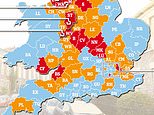Gilts could prove a lucrative bargain, as analysts eye a looming bounce-back after UK Government debt sold off sharply heading into the Autumn Budget.
Two, five and 10-year gilt yields have slumped almost 40 basis points each over the last month as markets have digested the impact of £40billion worth of tax hikes, increases to public spending and the potential for fewer Bank of England interest rate cuts.
Market pricing now suggests the BofE's base rate will settle at 4 per cent by the end of 2025, 75bps below its current level of 4.75 per cent and 50bps ahead of terminal rate expectations of 3.5 per cent just a month ago.
Samuel Adams, economist at UBS, blamed 'split minds about the interest rate outlook seem to bear much of the responsibility' for gilt market wobbles – as opposed to 'concerns about fiscally lax politicians'.
He added: 'This is an opportunity to take advantage of, we think. Vibes about the economy, after all, can shift faster than we think.'
Fresh data from the Office for National Statistics on Wednesday will shine light on the bank's battle against inflation, with forecasters predicting the Consumer Price Index rate will rise from 1.7 to 2.2 per cent in October.

Thomas Watts, senior investment analyst at Abrdn, said: 'With many economists now expecting the BoE to hold fire on any more rates cuts during 2024 and even scaling back such moves during the coming year after an inflation inducing Budget, the numbers will take on added significance and could perhaps help set the tone for the rest of the year.'
Markets now expect the bank could hold fire on its next rate cut until March – or even June – next year, but significant progress on sticky services inflation this week could quickly shift forecasts.
Analysts at ING said markets have 'overreacted to the recent UK Budget announcement' and 'turned too hawkish on BofE cuts'.
ING expects 10-year yields to fall back to 4 per cent by mid-2025 – 'significantly lower' than their current level of 4.4 per cent.
However, the analysts cautioned that the market would need to see a 'series of better services inflation numbers' to convince traders 'of the BofE's ability to cut more than the meagre two or three total cuts currently priced in'.
BlackRock is currently overweight gilts, which it thinks will benefit as the BofE prepares to 'cut rates more than the market is pricing given a soft economy'.
And some groups of retail investors appear to be well positioned if yields - which move inversely to price - do move lower.
TN25 - a gilt maturing in January 2025 with a coupon of 0.25 per cent – was the most held position among the 25-34, 35-44, and 45-54 age groups among Interactive Investor users in the third quarter.


Similarly, exchanged traded funds tracking gilts saw $800million of inflows in October, according to Invesco.
Kyle Caldwell, funds and investment education editor at Interactive Investor, said: 'As interest rates rise, so do bond yields.
'As a result, income seekers have more options and can take less risk, as the safest types of bonds, such as gilts, offer yields of around 4 per cent compared to virtually nothing when interest rates were at rock-bottom levels.
'Falling interest rates could act as a catalyst for a change in fortunes for alternative income strategies, as well as other investment trusts that have been out of favour.'
DIY INVESTING PLATFORMS
Affiliate links: If you take out a product This is Money may earn a commission. These deals are chosen by our editorial team, as we think they are worth highlighting. This does not affect our editorial independence.
Compare the best investing account for you











